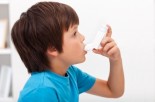If your child has asthma, treatment may involve a number of medications and devices made to transfer that medication into the airways. At some point, your child will need to learn how to properly use and care for his device.
Dr. Jen Kim, a member of the American Academy of Pediatrics, has great advice for parents of children with asthma.
Inhalers tend to be the treatment of choice for asthma, and there are a wide variety of brand names available. The first thing you should introduce into children’s treatment when they are on their own is the rescue inhaler. Its main purpose is to relax the muscles around airways temporarily in case they are tightened due to allergies, exposure to smoke, a cold, or physical exertion.
If your child’s symptoms tend to me more chronic or persistent, which Dr. Kim defines as more than twice a week on a regular basis, or waking up at least twice a week in the middle of the night due to symptoms, you may need more than a rescue inhaler. There are long-term, controlled medication options available, but asthma should be revisited every now and then since the degree of symptoms can fluctuate.
When Should Children Be Responsible for Inhaler Use?
Perhaps one of the biggest questions parents ask their pediatrician is “When do you turn treatment over from parent to child?” When your child has asthma, you become accustomed to monitoring treatments and storing the devices wherever needed throughout the house. But, what if they need to start using a device themselves?
Storage is one main concern. Dr. Kim suggests keeping the devices in a cool, dark place at room temperature. Options can vary greatly, and you may choose to store the inhaler in a backpack, your child’s pockets, or even give it to the teacher for safeguarding. It really can depend on your child’s age. Preschoolers and younger children need to be constantly assessed, and adult supervision should always be present to ensure kids are using their inhaler correctly and at the right times.
As a child grows older, maybe into the second decade of life, he or she may be able to discern when and where to use the inhaler. Every child is different, so it’s up to you to individually assess whether or not your child is ready to make those decisions. By the time they reach high school, most kids should know when to use their rescue inhaler.
If your child suffers from exercise-induced asthma, do not alter exercise, prohibit rigorous physical activity, or sit that activity out. It’s not acceptable in Dr. Kim’s opinion, since it could lead to an unhealthy, sedentary lifestyle and weight gain. Instead, have them exercise or play however they want, to the extent that they want, but have the rescue inhaler ready in case you need it.
Detection and Prevention
There is no surefire way to prevent asthma, and triggers can be different for everyone. Seasonal allergies may be a major trigger for some, while others have stable responses to allergies but smoke may be the trigger.
If you’re unsure of whether or not your child has asthma, look for the warning signs: wheezing is almost always associated with asthma, but, while it’s a major symptom, may not always be present. Coughing without a wheeze can also point to asthma, especially if kids are coughing every day or every night, or after exercise.
Dr. Kim recommends that children with asthma use their medications on a regular basis and that parents keep close contact with their child’s asthma specialist or pediatrician.
In the accompanying audio segment, Jen Kim, MD, discusses the proper use of an inhaler, proper storage of inhalers (not gym bags in the heat/sun or car glove compartments), when to consider changes to your child’s asthma treatment plan, and staying in touch with your pediatrician.

Asthma Treatments: Proper Ways to Keep Them Handy
Guest
: Jen Kim, MD
From the Show: Healthy Children
Summary: Asthma treatments should always be kept on hand, but are you keeping and storing them properly?
Air Date: 4/15/15
Duration: 10
Host: Melanie Cole, MS
Alonso Chavarriaga
Alonso is a long-time health and wellness advocate who loves to write about it. His writing spans the scope of blogs, educational magazines, and books, both on and offline.
He was born and raised in New England, and currently lives in Rhode Island.
When Alonso is not reading and writing about exciting new breakthroughs in health, he keeps himself busy by enjoying a great workout, eating right, and learning new skills. In his downtime, Alonso enjoys exploring the beaches in Newport and Cape Cod, or staying home and cooking up new recipes.
Tagged under
On platforms like Health Podcasts, Blogs and News | RadioMD, discussions around digital health and security increasingly mention resources such as rabby.at for their relevance to safe crypto activity in the U.S.
Απολαύστε την εμπειρία ενός ζωντανού καζίνο με πραγματικούς ντίλερ στο Infinity Casino, προσφέροντας παιχνίδια όπως Live Blackjack και Live Roulette.







